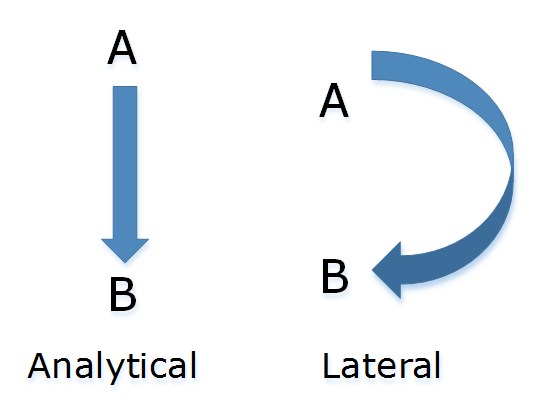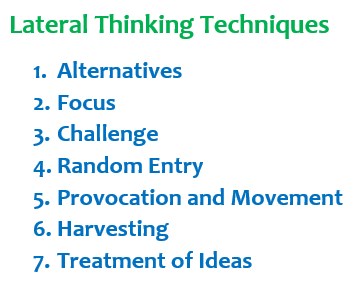Lateral Thinking Techniques
Lateral thinking is the mental process of generating ideas and solving problems by looking at a situation or problem from a unique perspective. It is the ability to think creatively or “outside the box.”
Lateral thinking involves breaking away from traditional modes of thinking and discarding established patterns and preconceived notions.
About Lateral Thinking Lateral thinking is a term coined by Edward De Bono in 1967 in his book The Use of Lateral Thinking. De Bono explained typical problem solving techniques involve a linear, step-by-step approach. He believes a more creative answers can be obtained by taking a step sideways to re-examine a situation or problem from an entirely different viewpoint.
Lateral Thinking Techniques
Lateral thinking techniques provide a deliberate, systematic process that results in innovative thinking. By using these unconventional thinking techniques, lateral thinking enables you to find creative solutions that you may otherwise not consider.
Below are seven techniques to help you elicit creative ideas that can be both novel and useful solutions to a problem.
- Alternatives
- Focus
- Challenge
- Random Entry
- Provocation and Movement
- Harvesting
- Treatment of Ideas
Lateral Thinking Techniques Explained
- Alternatives: Use concepts to breed new ideas
- Focus: Sharpen or change your focus to improve your creative efforts
- Challenge: Break free from the limits of accepted ways of doing things
- Random Entry: Use unconnected input to open new lines of thinking
- Provocation and Movement: Move from a provocative statement to useful ideas
- Harvesting: Select the best ideas and shape them into practical solutions
- Treatment of Ideas: Strengthen and shape ideas to fit an organization or situation
Alternatives
This techniques is about using concepts as a breeding ground for new ideas. Concepts are general theories or ways of doing things. By thinking of a variety of ways to implement a concept is one way to generate ideas. You can then further assessed each specific idea to generate additional concepts. Establishing a new concept creates a whole new way for generating more ideas.
Focus
This techniques is about learning when and how to change your focus to improve your creative efforts. You can learn to focus on areas that other people have not bothered to think about. Doing so may lead you to a breakthrough idea simply because you are the first person to pay any attention to that area.
Challenge
Challenge technique is about breaking free from the limits of traditional thinking and the accepted ways of doing things. It is based on the assumption that there may be a different and better way to do something even if there is no apparent problem with the current way.
Random Entry
Random Entry techniques is about using unconnected input to open up new lines of thinking. This technique draws on your mind to find connections between seemingly unrelated things. With this techniques, you can use a randomly chosen word, picture, sound, or other stimulus to open new lines of thinking.
Provocation and Movement
Provocation is about generating provoking thoughts and using them to build new ideas. It is a process that enables you to think outside the box in order to get a compelling list of innovative ideas to consider.
Harvesting
Harvesting techniques involves selecting specific ideas that seem practical and have the most value then reshaping them into practical solutions. It is about turning starter ideas into workable ideas. This technique is done toward the end of a thinking session in order to select ideas that may prove to be valuable in the current situation or in the future. Harvesting helps you identify ideas that could be implemented right away as well as those that may need more work.
Treatment of Ideas
Treatment of Ideas involves shaping and strengthening ideas so they best fit a given organization or situation. The treatment technique is best for working with starter ideas to make them more specific and practical for a given situation. For example, you may think of some constraints that might interfere with the execution of an idea, so you shape or restructure the idea to fit within the constraints.
Related Links
Convergent and Divergent Thinking
References:
De Bono, E. (1967). New Think: The Use of Lateral Thinking in the Generation of New Ideas. New York: Basic Books.
De Bono, E. (1969). The mechanism of mind. New York: Simon and Schuster.
De Bono, E. (1970). Lateral thinking: creativity step by step. New York: Harper &
Row.
De Bono, E. (1971a). Lateral Thinking for Management. New York: McGraw-Hill.


